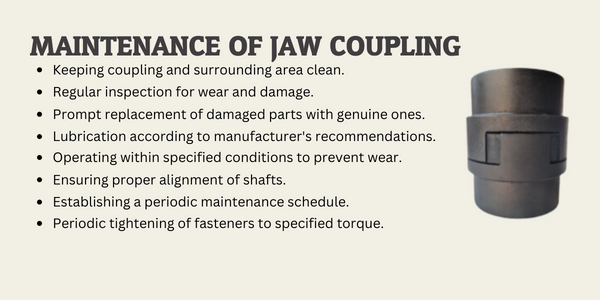Maintenance of Jaw Coupling: Ensuring Optimal Performance
Introduction
Welcome to the definitive guide on the Maintenance of Jaw Coupling by Coupling House. In this article, we will delve into the intricacies of maintaining jaw couplings, ensuring optimal performance and longevity for your machinery.
Understanding Jaw Couplings
A. What are Jaw Couplings?
Jaw couplings are mechanical devices used to connect two shafts together for transmitting power. They consist of two hubs with teeth and an elastomer spider placed in between. This design allows for flexibility while transmitting torque.
B. Types of Jaw Couplings
There are various types of jaw couplings available, including straight jaw, curved jaw, and insert jaw couplings. Each type caters to specific application needs, offering different levels of flexibility and torque transmission.
Importance of Maintenance of Jaw Coupling
Proper maintenance of jaw couplings is essential to ensure smooth operation and prevent unexpected breakdowns. Regular maintenance routines can significantly extend the lifespan of couplings and reduce the risk of costly repairs.
Signs of Wear and Tear
A. Visual Inspection
Inspect the coupling regularly for any visible signs of wear such as cracks, chips, or misalignment. Any irregularities should be addressed promptly to prevent further damage.
B. Performance Check
Monitor the performance of the machinery connected by the coupling. Any unusual vibrations, noises, or decrease in efficiency could indicate potential issues with the coupling that need attention.
Maintenance Procedures
A. Regular Lubrication
Ensure proper lubrication of the coupling elements to reduce friction and wear. Use lubricants recommended by the manufacturer and adhere to the specified intervals for lubrication.
B. Checking Alignment
Regularly check the alignment of the shafts connected by the coupling. Misalignment can lead to excessive stress on the coupling and result in premature failure.
C. Replacing Damaged Parts
If any part of the coupling shows signs of damage or wear beyond repair, it is crucial to replace it promptly. Ignoring damaged parts can lead to catastrophic failure of the coupling and surrounding machinery.
Troubleshooting Common Issues
Despite regular maintenance, jaw couplings may encounter issues such as misalignment, vibration, or overheating. Understanding the root cause of these issues is essential for effective troubleshooting and resolution.
Benefits of Proper Maintenance
Proper maintenance of jaw couplings offers several benefits, including increased equipment lifespan, reduced downtime, improved efficiency, and lower operating costs. Investing time and resources in maintenance can yield significant returns in the long run.
Expert Tips for Longevity
Implementing preventive maintenance measures such as regular inspections, proper lubrication, and alignment checks can significantly extend the lifespan of jaw couplings. Additionally, consulting with industry experts for guidance on maintenance best practices can further enhance equipment reliability.
- It's recommended to lubricate your jaw coupling according to the manufacturer's guidelines. Typically, this may range from monthly to quarterly intervals depending on usage and environmental conditions.
- Signs of misalignment in jaw couplings include abnormal vibrations, increased noise during operation, and accelerated wear on coupling components. Visual inspection may also reveal shafts that are not parallel or properly aligned.
- It's best to use lubricants specifically recommended by the coupling manufacturer. Using the wrong lubricant can lead to premature wear and failure of the coupling components.
- If you notice unusual vibrations in your machinery, it's important to investigate the root cause promptly. Check for misalignment, worn components, or imbalanced loads. Addressing the issue early can prevent further damage.
- Inspect the coupling regularly for signs of wear, including cracks, chips, or deformities. If any part of the coupling shows significant damage or wear beyond repair, it's advisable to replace it to prevent catastrophic failure.
- While basic maintenance tasks such as lubrication and visual inspections can often be performed by equipment operators, consulting a professional for complex issues or troubleshooting can provide valuable insights and ensure proper maintenance practices are followed.









